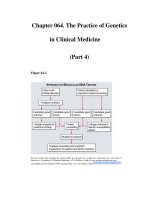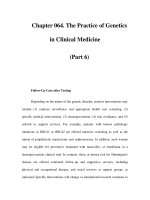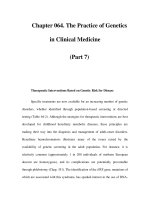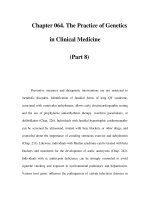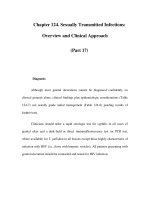Chapter 124. Sexually Transmitted Infections: Overview and Clinical Approach (Part 18) Table 124-8 pps
Bạn đang xem bản rút gọn của tài liệu. Xem và tải ngay bản đầy đủ của tài liệu tại đây (15.23 KB, 5 trang )
Chapter 124. Sexually Transmitted Infections:
Overview and Clinical Approach
(Part 18)
Table 124-8 Initial Management of Genital or Perianal Ulcer
Usual causes
Herpes simplex virus (HSV)
Treponema pallidum (primary syphilis)
Haemophilus ducreyi (chancroid)
Usual initial laboratory evaluation
Dark-field exam, direct FA, or PCR for T. pallidum
; RPR or VDRL test for
syphilis (if negative but primary syphilis suspected, repeat in 1 week); culture,
direct FA, ELISA, or PCR for HSV; consider HSV-2-specif
ic serology. In
chancroid-endemic area: PCR or culture for H. ducreyi
Initial Treatment
Herpes confirmed or suspected (history or sign of vesicles):
Treat for genital herpes with acyclovir, valacyclovir, or famciclovir
Syphilis confirmed (dark-field, FA, or PCR showing T. pallidum
, or RPR
reactive):
Benzathine penicillin 2.4 million units IM once to patient, recent (e.g.,
within 3 months) seronegative partner(s), and all seropositive partners
Chancroid confirmed or suspected (diagnostic test positive, or
HSV and
syphilis excluded, and lesion persists):
Ciprofloxacin 500 mg PO as single dose or
Ceftriaxone 250 mg IM as single dose or
Azithromycin 1 g PO as single dose
Note
: FA, fluorescent antibody; PCR, polymerase chain reaction; RPR,
rapid plasma reagin; ELISA, enzyme-
linked immunosorbent assay; HSV, herpes
simplex virus; VDRL, Venereal Disease Research Laboratory.
Typical vesicles or pustules or a cluster of painful ulcers preceded by
vesiculopustular lesions suggests genital herpes. These typical clinical
manifestations make detection of the virus optional; however, many patients want
confirmation of the diagnosis, and differentiation of HSV-1 from HSV-2 has
prognostic implications, since the latter causes more frequent genital recurrences.
Painless, nontender, indurated ulcers with firm, nontender inguinal
adenopathy suggest primary syphilis. If dark-field examination and a rapid
serologic test for syphilis are initially negative and the patient will comply with
follow-up and sexual abstinence, the performance of two more dark-field
examinations on successive days before treatment is begun will improve the
sensitivity of the diagnosis of syphilis, and repeated serologic testing for syphilis 1
or 2 weeks after treatment of seronegative primary syphilis usually demonstrates
seroconversion.
"Atypical" or clinically trivial ulcers may be more common manifestations
of genital herpes than classic vesiculopustular lesions. Specific tests for HSV in
such lesions are therefore indicated (Chap. 172). Type-specific serologic tests for
serum antibody to HSV-2, now commercially available, may give negative results,
especially when patients present early with the initial episode of genital erpes or
when HSV-1 is the cause of genital herpes (as is often the case today).
Furthermore, a positive test for antibody to HSV-2 does not prove that the current
lesions are herpetic, since nearly one-fourth of the general population of the
United States (and no doubt a higher proportion of those at risk for other STIs)
becomes seropositive for HSV-2 during early adulthood. Although even type-
specific tests for HSV-2 that are commercially available in the United States are
not 100% specific, a positive HSV-2 serology does enable the clinician to tell the
patient that he or she has probably had genital herpes, should learn to recognize
symptoms, should avoid sex during recurrences, and should consider use of
condoms or suppressive antiviral therapy, both of which can reduce transmission
to a sexual partner.
Demonstration of H. ducreyi by culture (or by PCR test, when available) is
most useful when ulcers are painful and purulent, especially if inguinal
lymphadenopathy with fluctuance or overlying erythema is noted; if chancroid is
prevalent in the community; or if the patient has recently had a sexual exposure
elsewhere in a chancroid-endemic area (e.g., a developing country). Enlarged,
fluctuant lymph nodes should be aspirated for culture or PCR tests to detect H.
ducreyi as well as for Gram's staining and culture to rule out the presence of other
pyogenic bacteria.
When genital ulcers persist beyond the natural history of initial episodes of
herpes (2–3 weeks) or of chancroid or syphilis (up to 6 weeks) and do not resolve
with syndrome-based antimicrobial therapy, then—in addition to the usual tests
for herpes, syphilis, and chancroid—biopsy is indicated to exclude donovanosis,
carcinoma, and other nonvenereal dermatoses. HIV serology should also be
undertaken, since chronic, persistent genital herpes is common in AIDS.



